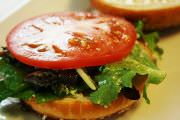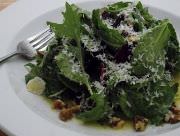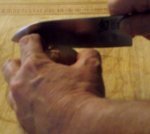Knife Sharpening Techniques
I don’t think there is one single thing that creates as much confusion in professional kitchens as knife sharpening. Nor is there anything that has so many myths and opinions circulating around it.
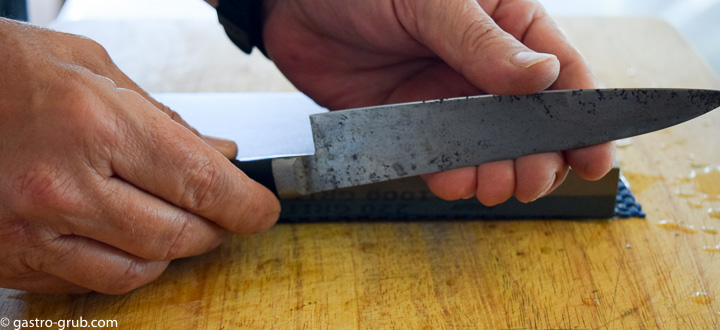 Feeling the blade edge by running my thumb across the edge.
Feeling the blade edge by running my thumb across the edge.Way back, when I was a line cook some guy came to work in our kitchen. I can’t even remember his name, he didn’t last long. However, I do remember him saying to me, one day, that to sharpen a knife you have to run it along a steel 30 times on each side. Good Gawd!
I know I've said it before but I want to be crystal clear on this point, a steel is for honing a knife only, it does not, and indeed can not, sharpen a blade. What it does do is straighten the edge of the blade. Unfortunately, I don't have the microscope necessary to demonstrate, but, as you use your knives the very fine cutting edge develops blade rollover. A steel or honing stone is used to correct this.
There isn’t one right way to sharpen knives. There are several methods and tools that produce good results, diamond steels, whet stones, oil stones, and knife sharpeners. While sharpening, you can hold the knife so that the cutting edge is facing you or facing away from you. For honing knives you use a steel or a super high grit stone, like an 8000 grit whet stone.
As well, there isn’t some set period of time or usage for sharpening knives. You sharpen your knife when it begins to lose its edge. Obviously, this will be affected by usage. Once a blade loses its edge it is far more difficult to get it back and it takes far longer. Some cooks sharpen their knives at the end of each day. While this approach does make it very easy to maintain a razor sharp edge, necessary for a professional cook, it also shortens the lifespan of the blade.
If you don’t have a lot of experience sharpening knives a good knife for developing your knife sharpening technique is an inexpensive carbon steel knife, because of the softer metal carbon steel knives will take an edge far faster and easier than a hardened steel knife. In addition you can pick up a carbon steel knife for 40 to 60 dollars. While that isn’t the cheapest knife out there it is still substantially cheaper than a Misono, Wusthof or Shun that runs well over a 100 dollars. Once you are satisfied with the results you're getting, then move onto sharpening your better knives.
One last point to mention, if you poke around the web for knife sharpening techniques you’ll see that many sites start off by telling to hold the knife at “such and such” angle, whatever their idea of such and such is. This is flat out WRONG. Different knife manufacturers use different angles to create the edges of their knives. For example, take a look at Wusthof knives as compared to Shun knives:
Our sharpening angle for standard blades is 14 ̊ per side, and for Asian-style blades (Santokus, Nakiris, Chai Daos) is 10 ̊ per side:
Shun offers several whetstones as well as a three-piece Sharpening System that includes a honing steel, whetstone, and a bamboo stand angled to 16° that makes sharpening easy.
As is illustrated they use different angles to produce their edge. To maintain the edge of your knife the best bet is to do a little research to determine the angle to use for the make of your knives.
Knife Sharpening Techniques For A Razor Sharp Edge
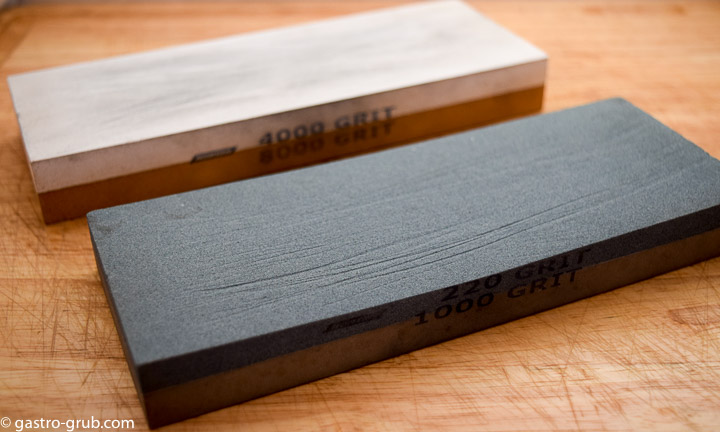
Sharpen your knives on a whet-stone. These stones are double sided whetstones. That is, they are made of two different stones fused together providing you with two different grits in one stone.
The 220 grit side is for cutting an edge on a knife that has completely lost its edge or is damaged in some way, like a broken tip, which by the way is how I got the grooves you can see in the stone. The 1000 grit side is for finishing the edge.
The 4000 and 8000 grit stone is for honing and polishing the blades.
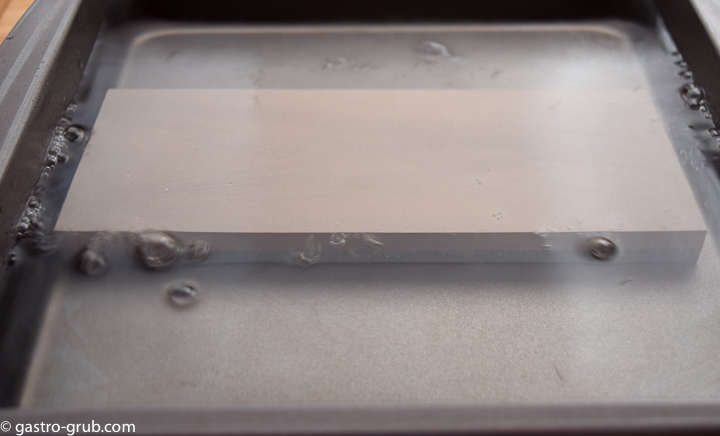
Soak the stones but do not over soak them. Submerse them in a clean water bath. You’ll see bubbles escaping the stone. When the bubbles stop, give them another 5 minutes, then remove the stones from the water bath. Over-soaking will decrease the stone’s quality and make sharpening more difficult. After sharpening, rinse the stone under cold running water, blot dry, and allow to air dry completely before returning the stone to its container. It is actually better to store stones in a clean dry lint free towel.
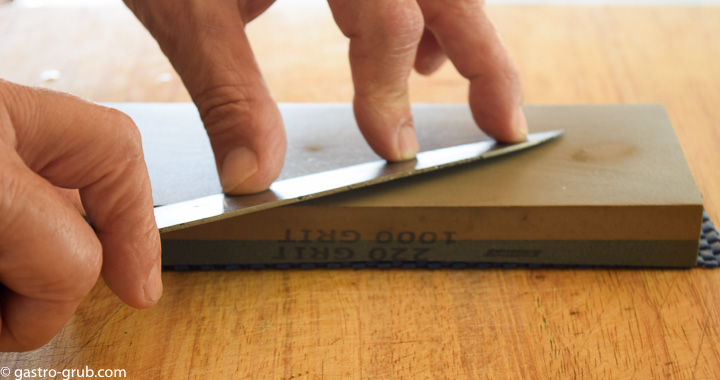
Place the stone on a damp kitchen towel to prevent movement while sharpening. Alternatively, you can pick up a rubber mat like I have. You can just make it out in the picture, under the stone.
Grasp the knife with your dominant hand and place your index finger on the spine of the blade. Use your remaining fingers to hold the handle.
You need to decide whether you want to sharpen the blade with the cutting edge facing you or facing away from you. Neither method is right or wrong, they are different methods and it becomes a function of which you prefer. I sharpen my knives with the cutting edge facing me, it’s just my preference.
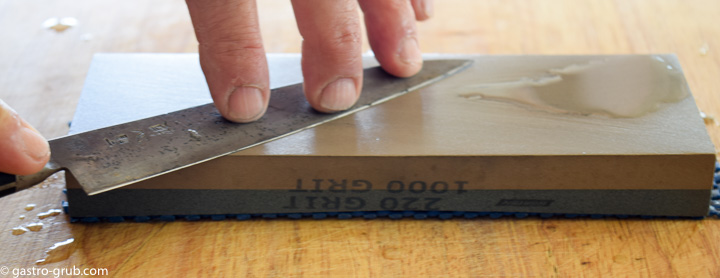
Starting with the tip of the knife, Use two or three fingers of your free hand apply a light but firm pressure on the blade as it contacts the stone.
Press the edge of the blade to the stone and push along the stone, exerting pressure as you move forward and releasing pressure as you return the blade to its starting position.
There are two ways of doing this, you can move the knife from tip to heel as the blade runs against the stone, as if you were slicing through a piece of bread. This is how I do it. Alternatively, you can simply move the blade up and down the stone at one fixed position, after a few strokes move the blade to the next position and continue on until the entire blade is sharpened. Personally, I’m not a fan of this method.
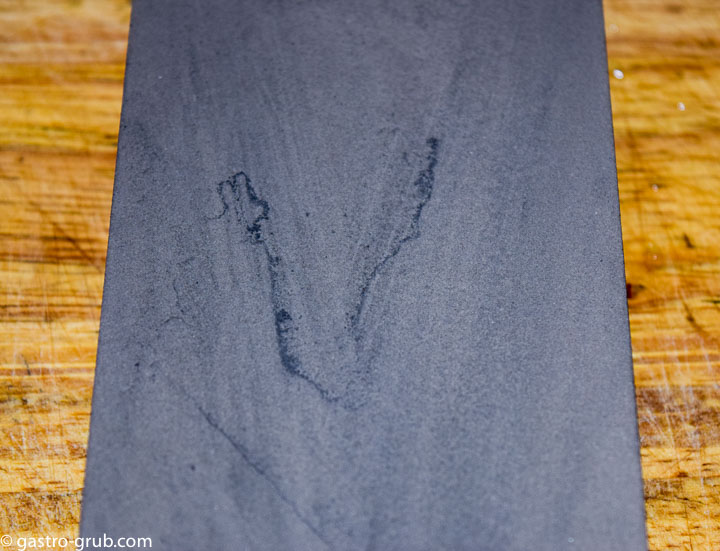
As you are sharpening your knives you will notice a gradual buildup of steel on the stone. This is good it helps to put the edge on the blade.
That darker random line in the picture is what I am talking about, though it doesn't really photograph well.

Constantly check the edge of the blade as you sharpen it. You can do this by running your thumb or finger across the blade. Do it lightly and drag your thumb perpendicular to the blade.
Do not slide your thumb or finger up and down the blade, unless you really like stitches.
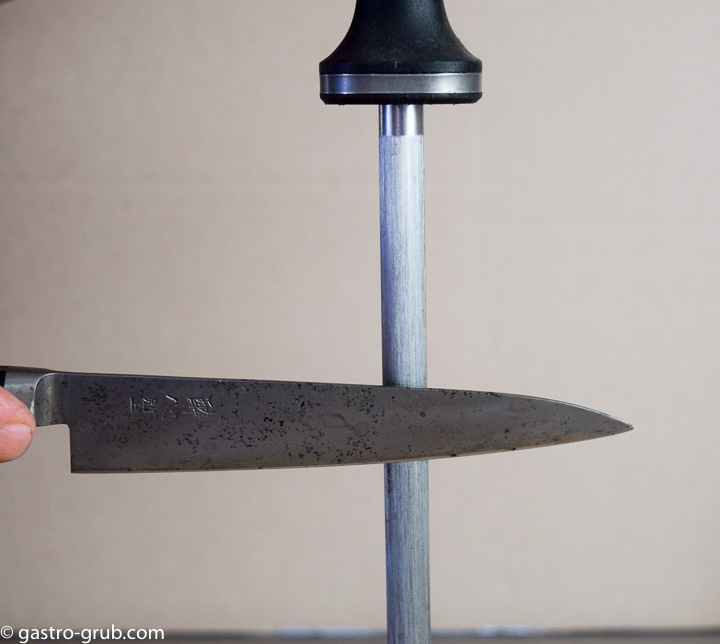
Once you finish sharpening the knife, it is important to hone the edge of the blade. You do this by running the blade across a steel. Alternatively, you can hone the edge by running it over an 8000 grit whetstone.
To hone the blade hold the knife at the same angle you used to sharpen it and slice down the steel while pulling back, as if you were slicing through something.
Ceramic Knife Sharpening Techniques
Ceramic knives present a different challenge. They must be sharpened with a diamond steel or a diamond sharpener. Diamond steels are available from several companies, however, diamond sharpeners should be purchased from the manufacturer of the ceramic knife. This is because the sharpener is designed to preserve the specific angle of the original knife.
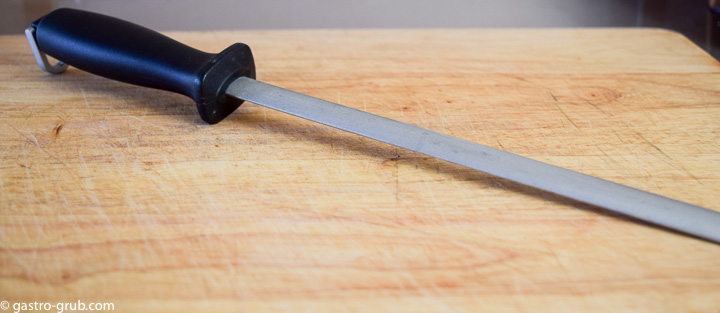
Grasp the knife with your dominant hand.
Hold the steel in your other hand.
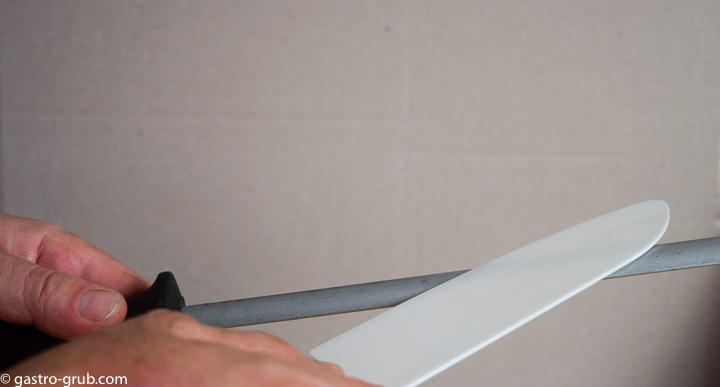
Maintaining the approximate angle of the knife edge, slice down the length of the diamond steel, while pulling the blade across the diamond steel.
Repeat this action on the opposite side of the knife edge. Continue repeating until you achieve a razor sharp edge.
Knife Sharpening Techniques For Traditional Japanese Knives
Sharpening traditional Japanese knives is a more complex process. Many Japanese knives are sharpened on one side only, Global knives for example, and the process is a little different. Honestly, traditional Japanese knives require more work to maintain than many home cooks are going to be willing to put in.
I am a classically trained professional chef and almost every knife I own is a western style knife, including my Japanese knives. Frankly, I can put an edge on my Wusthof chef’s knife that is every bit as sharp as the edge on many traditional Japanese knives.
For those who want to go the route of traditional Japanese knives here is an outline of the steps necessary to properly maintain the edge.
First, traditional Japanese knives should be sharpened right out of the box.
Sharpen the entire cutting edge until there is a slight and even burr on the reverse side.
Turn the blade over, and place the blade perpendicular to and flat against the stone. Remove the burr with your middle and index finger gently pressing the edge to the stone and your thumb gently pressing the spine. Imagine you are trying to push water off the stone.
Flip the blade over again and sharpen by moving your fingers away from the edge and pressing just below the middle of the blade. This step is necessary to obtain the legendary razor sharpness of traditional Japanese knives.
Tags: knife sharpening techniques, how to sharpen knives, sharpen japanese knives, sharpen ceramic knives
